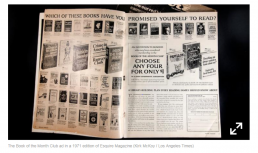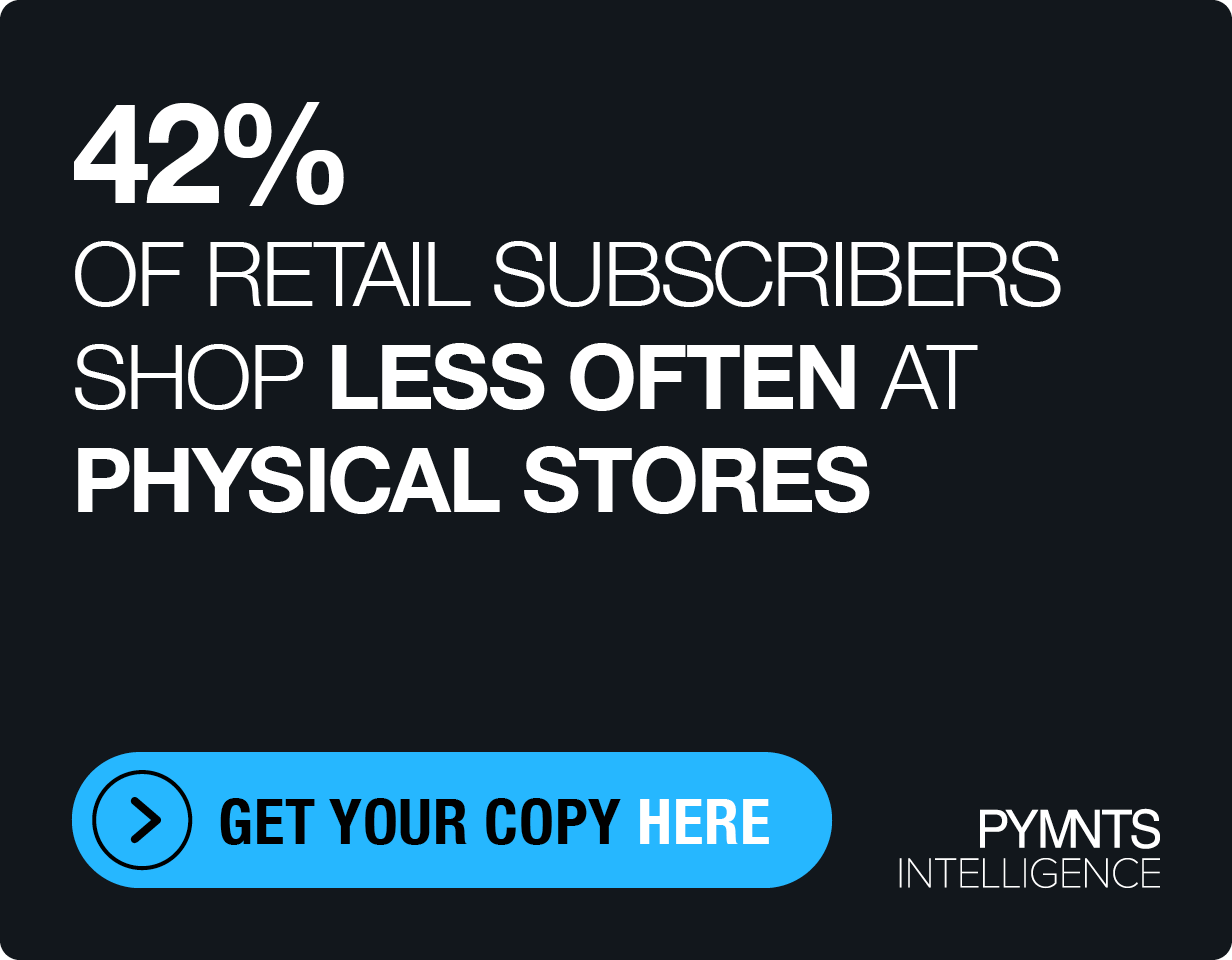What The Book Of The Month Club Can Teach Retailers About Taking On Amazon

Thousands of little brown boxes of books, delivered by the post office all over the U.S., are sent every day to book lovers, who eagerly await the chance to dive into their latest literary indulgence.
Getting those books doesn’t require going to a bookstore. Most purchases were recommended by experts, often celebrated authors themselves, who curated lists of great reads or debut authors to pick from. Convenience, plus the advice of experts to help shorten that list of books, has become the winning formula for book lovers, the authors who want to reach them, the intermediary that brings those two together and the business model that made the captive audience sticky.
That winning formula saw its debut not in 1995 when Amazon began selling books online, but in 1926, when advertising copywriter Harry Scherman founded The Book of the Month Club (BOMC) with a monthly membership subscription model.
It’s a model that has also, over the last five or so years, given birth to a variety of new digital commerce platforms interested in creating their own captive audiences for expanding the application of subscription commerce beyond digital goods to products. It’s a model that, along with selling products, gives those platforms a chance to build valuable data assets that can also better understand member preferences — and leverage the economic benefits of the predictive model it creates and enriches over time.
A model that, some 92 years later, is even hoping to revive the business that first put it on the map.
Subscribe to Be a Member
Scherman was convinced in 1926 that the only thing holding book lovers back from reading was easy access to the books they’d most like to read. Book lovers, he theorized, would love owning the books they read, if it was easy and affordable. In 1926, that wasn’t exactly accomplished by hopping in the car and zipping to the mall or firing up a Kindle to buy a must-have read online.
Back then, if someone wanted to read a book — never mind buy it — they went to the library. Walking in, they hoped they timed their trip well enough to get the book they wanted, and, walking out, they hoped they’d have the time to finish it before it was due back into the loving arms of the librarian.
If someone wanted to buy a book, their only option was to hope for the best at a local gift shop or drugstore. There, they were forced to pick from a small number of popular hardcover titles that the store had the room to display. Bookstores then were neither widely available nor easily accessible.
Observing that, Scherman decided to tap into book lovers’ desire to be part of a “club” that gave them access to the great reads they’d want to buy and keep in their homes. His innovation was to leverage the most efficient delivery method available at the time — the friendly, familiar and reliable mailman — and to build a mail-order, subscription-based, membership business around it. Each month, members of the BOMC were offered the chance to review and then buy from a curated selection of recommended reads that could be sent directly to their homes.
His initial hook was an offer to purchase four popular titles for one dollar. With books at the time selling for about ten times the price of a $0.20 movie ticket, that was a good deal. Anyone who did that became a member of BOMC. Then, each month thereafter, members received a catalogue featuring a selection of curated picks and were given a few days to review and send in their selection. If they did nothing, they would get the featured selection shipped to them automatically. Members paid full price for whatever they bought, plus postage, and were required to buy four books a year to remain a member in good standing.
BOMC’s sales and distribution model turned out to be a big hit.
By the end of its first year in 1926, BOMC membership ranks grew to 46,539, with reported sales of $500,000. By the beginning of its second year, BOMC membership had more than doubled to 100,000 — all the result of word-of-mouth promotion.
Part of that promotion was members raving about easy access. But it was more than that, too. Members valued easy access to a high-quality selection of books vetted by experts with a knack for discovering famous authors before they became famous. Being a member of the Book of the Month Club meant getting access to debut novels written by those up-and-comers with the ease of mail-order delivery.
When BOMC launched in 1926, it did so with Ernest Hemingway’s first novel, “The Sun Also Rises.” In its tenth year, one of BOMC’s featured picks was a book by a relatively unknown author, who won a Pulitzer Prize a year later and whose novel remains today the second most well-read book besides the Bible. That author was Margaret Mitchell, and that book was “Gone With the Wind.” In 1978, BOMC put now-bestselling author Nelson DeMille on the map by making his first book, “By The Rivers of Babylon,” its featured pick. DeMille and his publisher publicly acknowledged that its BOMC debut made the book an instant bestseller.

Over the years, having those titles on display on bookshelves in living rooms and family rooms across the country became status symbols, an incentive for members to keep buying, while motivating their non-member friends to become part of the club, too. That success delivered economic bargaining power that BOMC leveraged to its advantage for the better part of its first fifty years.
The popularity of the books offered by BOMC drove sales of those same titles at bookstores, which, naturally, authors and their publishers loved and from which they reaped the financial rewards. BOMC parlayed the power and influence of its membership model in selling books on and off its platform to keep its string of securing first dibs on marketing rights intact, paying publishers handsome upfront advances for that privilege. They did that because they had developed a keen sense of what their members bought and wanted to read. That dynamic also made it easier for BOMC to recruit more authors and drive down the prices they paid for books. Those discounts were passed on to its members, which kept them happy and encouraged them to buy even more.
Nearly 30 years later, in the mid-1950s, BOMC evolved its model further. Its feature pick was discounted, and any additional books purchased could be bought at an even steeper discount. BOMC reported selling 5 million books a year then, while boasting that it had placed more books in private homes than the total number of books that existed in all public libraries and universities combined.
Any kid growing up in the 50s, 60s and even the early 70s probably has fond memories of watching their mom (usually) pore through the BOMC catalogue to make her picks. And then watching her wait for the mailman to deliver a little brown box filled with her very own copy of Jacqueline Susann’s “Valley of the Dolls” or Arthur Hailey’s “Hotel” — knowing well the bragging rights that went along with getting them first (and at a discount).
The BOMC Boomerang
The rise of television, the mass distribution and rising popularity of the paperback format, malls with bookstores, supercenters like Walmart and Costco emerging as important outlets for selling books in the late 1970s and early 1980s — all these things began to take a toll on BOMC membership.
As did the rise of Amazon in 1995 and the ease of buying books online at a steep discount. All at once, all three of BOMC’s core value propositions were leveled and its business model set adrift.
Mail order went the way of the typewriter — a quaint relic of a very different time. Convenience and price were being redefined on Amazon’s terms. Curation took a back seat to the blockbuster bestsellers that then dominated book sales. A string of acquisitions and takeovers followed, as did the dismantling of the panel of experts that once gave BOMC its unique edge. By 2001, BOMC saw its membership ranks shrink by 50 percent to roughly 700,000, diminishing by another 50 percent in the years that would follow.
Today, BOMC is taking a page out of its old playbook to revive its brand and keep pace with the times.
New BOMC members can sign on for free. A panel of author experts chooses five selections each month, which can be purchased for $14.99 each; subsequent books can be purchased for $9.99 each. Selections include a mix of bestsellers and debut authors, once again buffeting its allure to book enthusiasts interested in discovering new and interesting reads. Shipping is free. Members also have a choice in what’s sent to them, along with an option to skip a month without a penalty if nothing suits their fancy. Social media is used heavily to recruit new members and keep existing ones engaged. Members accrue rewards for purchases made and any new members they recruit. BOMC executives say that they are pleased with membership growth so far.
This 92-year-old model is at the core of what others more recently have emulated and are using to turn today’s more traditional subscription commerce business on its head.
For these businesses, the exchange of value is an introductory offer of a product that is priced quite low. Often that product is for a brand that’s exclusive to that platform. Buying that product is a condition of becoming a member, which then unlocks other VIP benefits. Those benefits include products tailored to members based on very specific information they have provided about what they like, what size they are, how they will use the product and more.
But here’s where things begin to look quite different.
Like BOMC, rather than of getting a box of “surprise” products each month, members are presented with options specific to their preferences that they then can purchase. What members see are the selections tailored to their preferences — people who like red won’t be shown orange; people who say they wear a medium won’t be shown extra-small or extra-large sizes. All selections are also often vetted by experts, and some even include celebrity endorsements.
With more members and more purchases from those members comes more intelligence about member preferences. More intelligence helps these platforms better anticipate demand, source products and manage inventory and the costs that follow, which delivers even more value to members in the form of better, often unique, inventory offered at lower prices.
The really good subscription models make it easy for members to know that the initial purchase means they’ve signed on as a member and can cancel membership at any time. The hope, though, is that they won’t, since what they see each month reflects the things they’d be more likely to buy, at prices that reflect their VIP membership status.
The really, really good ones don’t make consumers buy anything at all and proactively skip a month to remain a member — creating a trusted buying environment that encourages members to purchase more and more often.
It’s also very different than what most box-of-the-month clubs offer today.
Thousands of “box-of-the-month” retail products seem to follow the same formula: lure consumers in with an offer to get the first box dirt cheap or even free, then pay a monthly fee to get another box each month. Box contents are determined after subscribers answer a few qualifying questions. Based on those answers, consumers receive a box of surprises that more or less meets those general criteria. If the consumer doesn’t like what’s been picked, they can send the box back or, in some cases, opt to keep it at a discount. Sometimes, but not always, those kits are filled with unique brands only available from that box-of-the-month supplier.
These subscription businesses make their money by placing bulk orders for a zillion red shirts in a variety of sizes — or hundreds of pounds of bananas or hamburger-shaped dog toys — and then hoping enough customers are OK with getting their monthly box of surprises long enough to eke out a profit before they cancel.
Offering subscribers that choice and putting the customer in control is something that our Subscription Commerce Conversion Index measures every quarter and is shown to have a material impact on whether a subscription business keeps or churns customers. It’s why streaming services fight hard to produce original content and give consumers a lot of options to choose from, or duke it out to earn the right to have new releases available first on their platforms.
TechStyle’s Kate Hudson’s Fabletics athleisure clothing is one brand that’s using a membership model to change the way women buy what they wear to work out. The company has amassed 1.5 million members in the two years it’s been in business, and its members buy from the brand three times a year, on average. Assuming a $50 order for every purchase — there’s free shipping on any order over $49.95 — Fabletics’ annual sales could reach several hundreds of millions of dollars a year. According to its CMO, Shawn Gold, the company has plans to expand membership privileges to include complementary products and services, like fitness memberships, increasing its revenue streams accordingly.
That’s just one example.
When it comes to selling retail products one box and one month at a time, giving consumers a say in what they buy before they get it in the mail is a trend worth watching. Getting that model right offers a way for businesses to build a customer base in categories that consumers find attractive today — consumers who appreciate the convenience of easy access and delivery and the appeal of a unique, curated selection of quality products offered to them at discounted prices.
It’s also a way for those businesses to capture data about their members’ preferences, which can sharpen their competitive advantage and help them compete in a world where most U.S. households belong to Amazon Prime but still value the curated selections that Amazon with its size and scale doesn’t address.
It might even be a bit ironic that the business model Amazon unhinged in the late 1990s could help retailers compete effectively today when they use it.
It’s also a model that retailers don’t have to be a box-of-the- month club to consider. It sure would be nice if the VIP memberships that many retailers dangle in front of customers tailored offers based on VIP member preferences, instead of blanket discounts on everything or selections based only on what they might have purchased in the past.
